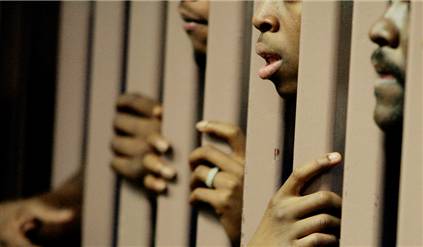 One good thing about the Supreme Court’s ruling two weeks ago that California had to reduce its prison population is that, for once, we are getting a relatively honest debate on crime and incarceration. Part of that is due to the relatively low crime rates, so the population is not automatically convulsing into knee-jerk reactions.
One good thing about the Supreme Court’s ruling two weeks ago that California had to reduce its prison population is that, for once, we are getting a relatively honest debate on crime and incarceration. Part of that is due to the relatively low crime rates, so the population is not automatically convulsing into knee-jerk reactions.
Dan Walters in his column this morning writes, “While liberal critics of the state’s criminal justice system hailed it as a long overdue wake-up call for reform, conservatives raised the specter of felonious hordes being released to prey upon the public.”
He adds that while supporters of tougher prison policies point toward these sentencing laws as the cause of the steady drop in the crime rate, researchers like Robert Nash Parker, a professor at the University of California, Riverside, disagree.
Writes Mr. Walters, “As the Supreme Court was issuing its ruling and Harris was announcing a decline in violent crime, Parker was circulating his new study contending that three-strikes and other sentencing laws had virtually nothing to do with the state’s decreasing violent crime rate.”
Citing “logic, data and research,” Professor Parker contends that “all these uniformly show little or no impact of three strikes policy on violent crime rates in California and elsewhere.”
According to Dan Walters, “He compared historic crime patterns in California and other states with similar laws to those without such laws and found they ‘show little difference in … pattern of violent crime.’ “
Mr. Walters adds, “Parker cites other studies that attribute crime rate declines to economic and social factors, such as alcohol consumption, rather than policing and sentencing policies and suggests it’s ‘better to use alcohol policy to control violence than three strikes.’ “
“Were California to change its approach to crime and comply with the federal court order to reduce the prison population, he notes, it could save $2.3 billion a year in prison costs,” Mr. Walters notes.
“California needs to stop gorging itself at the all-you-can-eat buffet of imprisonment,” says Professor Parker.
The heart of Professor Parker’s research indicates that the law has cost the state billions of dollars per year.
“It ended up imprisoning a lot of people who had maybe one felony, violent felony, early in their life when they were a kid and had pretty much straightened out,” Professor Parker told KABC TV in Los Angeles last week. “Maybe a few minor offenses after that, but because of the law it captured up this whole population.”
Among other problems with attributing the three strikes law to lower crime rate, is the fact that the drop in crime predates three strikes.
While Professor Parker has called the ruling by the courts, an “impetus for change,” he at the same time argues that “it ignores the elephant in the room—the Three Strikes and You’re Out Dilemma.”
“Until we address the wall of resistance to modifying or repealing the Three-Strikes law and reduce our appetite for incarceration,” he added, “California is simply kicking the can down the road.”
The law takes discretion away from the Judges and toward proescutors.
A report in New American Media argues, “Prosecutors have the greatest discretion; they may decide whether to count certain crimes as strikes when they file their criminal complaint. Critics have charged that this system introduces the worst of both worlds: mandatory sentences for those charged under the law and unequal application of the law.”
The report continues, “Parker warns that Gov. Jerry Brown’s budget crisis driven plan to move inmates convicted of lowlevel and non-violent crimes into the custody of county officials combined with the state’s tough sentencing laws, particularly three strikes recidivism, is a cocktail for failure.
“On one hand you’ve got the Justices ordering inmate reductions. On the other hand you’ve got people serving life terms for minor crimes contributing to the prison overcrowding and causing even further financial strains on the state,” Professor Parker said.
The New American Media goes on to report on a lecture “Worse Policy After Bad: Why and How Three Strikes is a Complete Failure as Crime Policy” at the University of California Center Sacramento May 26. During that lecture Professor Parker “warned against fear mongering and took direct aim at claims that the state’s tough on crime polities, most notably its three strikes law, is responsible for a 100% crime drop since 1992.”
“These assumptions are patently false and irresponsible,” Professor Parker told the audience. “Research and a logical examination of data on violent crime state by state over the past 50 years conclusively show that this is not the case.”
“A multivariate Vector time series model for California over the last 5 decades shows that the imposition of Three Strikes in 1994 has had no impact on the violent crime rate in the state, but that alcohol consumption and unemployment have important impacts on the rate of violent crime,” said Professor Parker.
As the New American Media reports, “Critics of the law point out that at the time California adopted its tough Three Strikes Law, New York and Canada, neither of which has a Three Strikes deterrent, enjoyed crime rate declines ballyhooed by Californians as being questionably attributed to the Three Strikes Law.”
Professor Parker, as reported by the New American Media article, “said research shows counties that aggressively enforced the law had no greater declines in crime than did counties that used it far more sparingly. One study found that crime dropped by 21.3% in the six most lenient ‘three strikes’ counties, compared to a 12.7% drop in the toughest counties.’ “
If these results are correct, said Professor Parker “the budget of California has suffered from a tremendous burden caused by the excess imprisonment of many nonviolent offenders under the Three Strikes policy.”
“I like to tell my students, California didn’t used to be known for incarcerating its citizens – but then the Soviet Union fell and Apartheid ended in South Africa. We were in bad company then.” Now, says Parker, “We’ve gone from being a ‘laboratory’ for Democratic policies to a poster child for incarceration.”
—David M. Greenwald reporting





Yet another reason why the three strike laws need to be repealed.
Remember it was only the early 1990s when we were all wringing our hands over crime rate increases. The concern was mostly concerns over violent crime. Although non-violent crime was also on a slight upward trend.
[img]http://upload.wikimedia.org/wikipedia/commons/thumb/6/60/Propertycrime-us.svg/500px-Propertycrime-us.svg.png[/img]
It was Clinton that campaigned on a platform of being tougher on crime and followed through.
[quote]“America’s families and communities faced serious crime problems in 1992. More violent crimes were reported in 1992 than ever before, with nearly two million murders, rapes, robberies and aggravated assaults occurring in the United States. Gun crime had skyrocketed to the highest point in 20 years with more than half a million total gun crimes reported. Parents fought a daily battle to keep their children away from drugs and gangs, as more young people than ever were involved in violent crimes. In 1992 alone, more than 850,000 children were victims of violent crime, and guns killed 5,379 children — an average of nearly fifteen every day. Communities struggled to fight crime, but the federal response remained bogged down in partisan differences.
President Clinton and Vice President Gore enacted policies that imposed tougher penalties and enforcement along with smart crime prevention measures, funded more than 100,000 new police officers on America’s streets, provided the leadership to pass common sense gun safety legislation including the Brady Bill and assault weapons ban, and implemented a comprehensive anti-drug strategy. [/quote]
I read something recently that attributed reductions in simple property crime to technology advances that make it more difficult for crooks. I think this makes sense, but I am not buying into the argument that three strikes is also not also responsible for a reduction in crime rates. At the very least, the incarcerated crooks cannot do crime number four.
The new area for concern is electronic larceny and ID theft. I would be in favor of stepping up the severity of punishment for these types of crimes, while introducing some greater leniency for petty crimes of youthful ignorance.
[quote]Mr. Walters adds, “Parker cites other studies that attribute crime rate declines to economic and social factors, such as alcohol consumption, rather than policing and sentencing policies and suggests it’s ‘better to use alcohol policy to control violence than three strikes.’ “[/quote]
I’m not understanding how crime rate declines based on alcohol consumption. What “alcohol policy to control violence” is Mr. Walters talking about?
[quote]“It ended up imprisoning a lot of people who had maybe one felony, violent felony, early in their life when they were a kid and had pretty much straightened out,” Professor Parker told KABC TV in Los Angeles last week. “Maybe a few minor offenses after that, but because of the law it captured up this whole population.” [/quote]
Huh? How can you say someone has straightened out if they then go out and continue to commit crime?
[quote]The report continues, “Parker warns that Gov. Jerry Brown’s budget crisis driven plan to move inmates convicted of lowlevel and non-violent crimes into the custody of county officials combined with the state’s tough sentencing laws, particularly three strikes recidivism, is a cocktail for failure.[/quote]
I strongly agree with this statement. The counties should not have to shoulder the burden of the state’s failed policies. The state needs to own its own problems, and come up with the solutions. And they should start with rethinking the three strikes law, which has been an abysmal failure IMHO.
[quote]“A multivariate Vector time series model for California over the last 5 decades shows that the imposition of Three Strikes in 1994 has had no impact on the violent crime rate in the state, but that alcohol consumption and unemployment have important impacts on the rate of violent crime,” said Professor Parker.[/quote]
What is being said here, that the crime rate has dropped bc alcohol consumption and unemployment have decreased? Really? Proof please…
Very thoughtful article on why crime rates have fallen:
[url]http://pricetheory.uchicago.edu/levitt/Papers/LevittUnderstandingWhyCrime2004.pdf[/url]
The four reasons given in this article are –
1) increase in the number of police
2) rising prison population
3) waning crack epidemic
4) legalization of abortion
Another interesting article from CA AG’s Office:
http://ag.ca.gov/cjsc/publicat…3sec3.pdf
Reasons given for drop in crime:
1) Effective strength of law enforcement agencies
2) Administrative/investigative emphasis on law enforcement
3) Policies of other components of criminal justice system (prosecutorial, judicial,correctional,probational
4) Citizens attitude towards crime (e.g. youth programs)
5) Population density/degree of urbanization
6) Variation in composition of population, especially youth concentration
7) Economic conditions (median income, poverty level, job availability)
8) Cultural factors and educational, recreational and religious characteristics
9) Family conditions with respect to divorce and family cohesiveness
10) Drug use – waning use of crack cocaine
11) Weapons – decrease in use by youth
Let me try than link again to CA Attorney General’s Office article:
http://ag.ca.gov/cjsc/
publications/misc/why/3sec3.pdf
Crime rates are reported per capita.
California’s population is aging.
Population growth is very low in the teenage demographic.
The most crime-prone age group is 15 – 24. In fact, if you want to stop crime, just lock up all 15 – 24 year-old males.
So the crime rate is going down because there are fewer young males per capita than there were a decade ago.
Perhaps a ballot initiative to modify (not eliminate) the 3 strikes law has a chance of passing:
To qualify as a 3rd strike, the crime must be a violent and/or weapons-related felony; perhaps even the 1st and 2nd strikes need to be such crimes to qualify as strikes.
That way, convicts won’t get life in prison for nonviolent and relatively minor felonies (e.g. drug use, shoplifting, etc.). These more minor crimes would have lighter sentences; much less prison time
I think most voters are most concerned about violent crimes; basically making sure the streets and neighborhoods are safe to live in and walk around in.
What do you think?
[quote]To qualify as a 3rd strike, the crime must be a violent and/or weapons-related felony; perhaps even the 1st and 2nd strikes need to be such crimes to qualify as strikes. [/quote]
I agree with you here. It would seem to me, at the very least, the third strike should be a serious felony of violence or use of a weapon. But I think prosecutors and many other law and order types look at the three strikes law as more of “clean-up” legislation to take habitual offenders off the streets. Hence the cheese thief was going to go away for a long time bc he could not seem to stop with the sticky fingers no matter how many times he went to jail. There is a certain amount of logic in that approach, but from a practical standpoint, I just don’t think it works…
I think what I would really like to know is what is cheaper, prison for such an offender, or some sort of diversion program? And when I say cheaper, I am including the cost of his repeat offending… any studies out there on this?